|
Africa
2024 Journal Pages:
1
2
3
4
5
6
7
8
9
10
11
12
January 20
We were back in the bush at six thirty. The sky was
clear and it was a beautiful sunny day! Right away we came
across something new; a pair of side-striped jackals
watched us furtively from the woods, and then shyly
slipped away. Compared to the foxlike black-backed jackals
we had been seeing, these were larger and more
coyote-like.
|
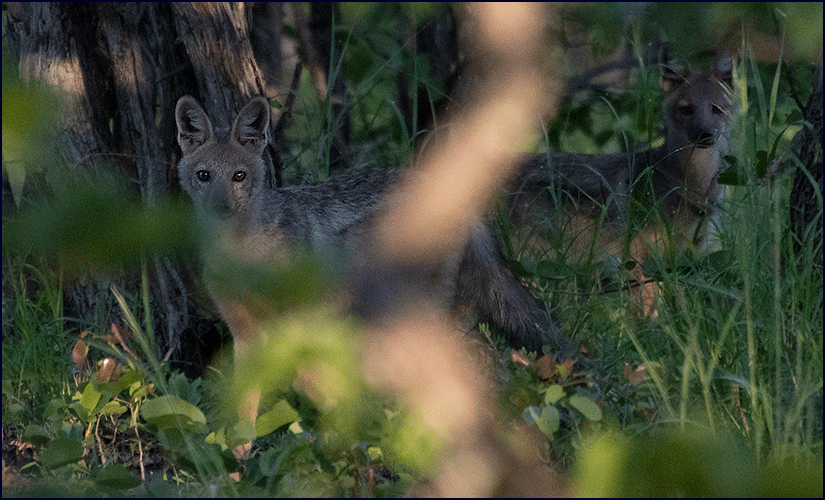
Side-striped jackals
|
Just moments later, three lovely giraffes meandered into
the road and stood there, dazzling in the brilliant early morning
light. We swung by an active hyena den; there was a burrow-like
opening to an underground den, but no hyenas were in sight. Gee
said we would check again in the evening when the hyenas were more
likely to be out in the open. We spent some time with some baby
zebras and their mothers. As always Gee was listening for alarm
calls in order to locate predators, but with no success this
morning.
Gee once again demonstrated his skills at reading tracks.
He showed us where a monitor lizard had crossed the road; we could
see the marks from its feet and tail. Then he pointed out some
large clumps of dirt about the size of elephant dung and told us
they marked the entrance to mole rats tunnels; Janell
misunderstood and referred to it as mole rat poop - Gee told her
that would be one big
mole!
We drove alongside the river. A hippo was out of the water
grazing. Clouds moved in mid-morning, but no rain.
The usual assortment of impala, wildebeests, lechwe,
waterbucks and warthogs were out and about, as well as all the
waterfowl that love the wetlands. A pair of spur-winged geese flew
right over our heads.
|
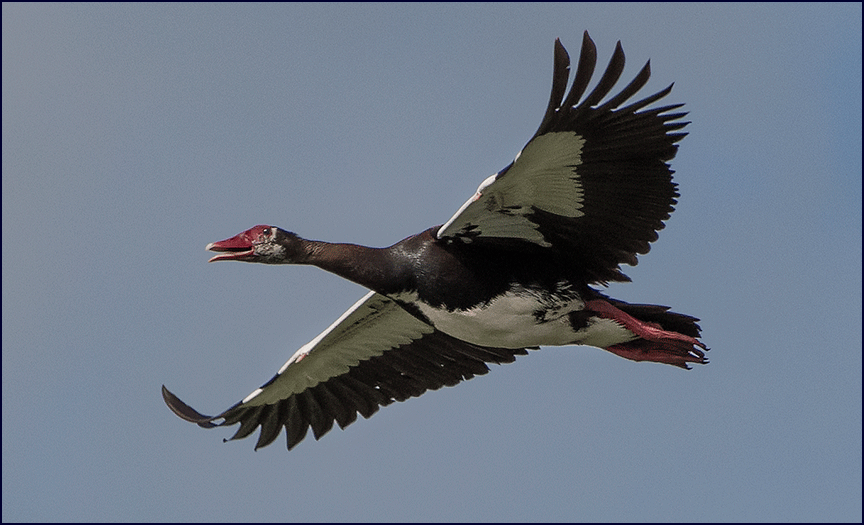
Spur-winged goose
|
We got a good view of a pin-tailed whydah; this small black
and white bird has a ridiculously long, elegant tail. We watched a
reed buck doe across the way as she hurried through the marshy
grassland.
|
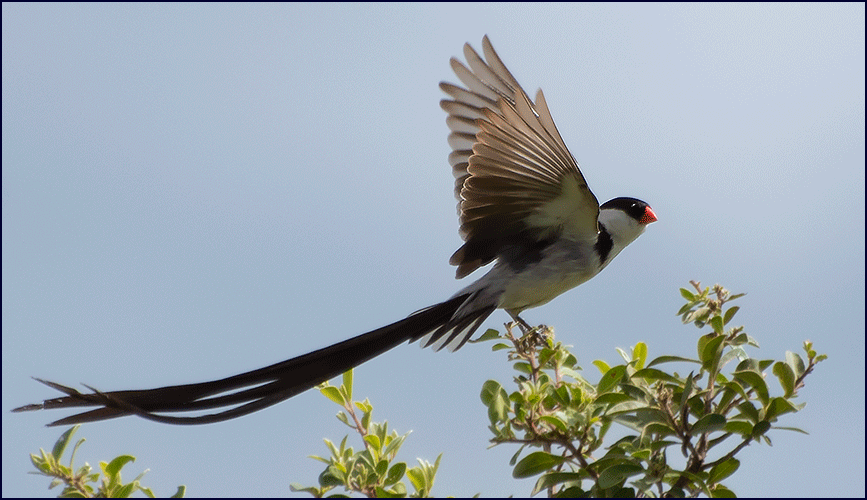
Pin-tailed whydah
|
Gee
received a radio call from a guide friend who told him a pair of
honeymooning lions had been seen in the area. When lions mate, the
pair will go off alone and breed dozens of times per day. This
couple had reportedly just finished such a tryst, and they were
looking to rejoin the pride. Gee’s friend had been following the
female, but she had gone across country and he lost her. Gee took
us to where the pair had last been seen and started looking for
tracks.
True to form Gee quickly
found the tracks, and following that spoor and alarm calls, he
soon found the lioness. She was walking slowly across the bushveld,
calling out in a low moaning voice, searching for her pride. She
walked on and on, sometimes circling and backtracking, and
periodically stopping to call out. We followed her - she was
exquisite. Female lions are more graceful than the males, and I
find them more beautiful.
Then the male lion came. Awesome and powerful, he walked
after the lioness, following her at a distance. The contrast
between the two was enthralling; where she emanated grace and
elegance, he exuded raw power. Eventually the male lost motivation
and lay down under a bush to rest. The lioness kept searching for
her pride, and we followed her for a while longer. She seemed
lonesome, and her call was mournful. We felt honored to get this
intimate look into her life. OMGMF.
We stopped around eleven by the river for a tea break. We
could still hear our lioness calling out; it made ‘going behind
a bush’ somewhat disconcerting. This prompted another of my bad
limericks:
The
cheetahs and leopards must have a plot
We searched for them but found them not
Though it was quite divine
To see lion thirty-nine
We would have gladly traded for something with spots
A Kori bustard was strolling along, with a couple of
carmine bee-eaters circling around him. A pair of sacred ibis hung
out close to the road. Two tawny eagles were squabbling in a tree,
impressive wings outstretched.
I was trying to get better at identifying the trees. The
acacia trees, with their flattish tops, characterize the
quintessential African landscape. The shepherd trees have peeling
white bark. The leaves
of the mopane trees are shaped like angel wings. The apple-leaf
trees have smooth grey/white bark; for the first time I realized
how much look like apple trees in an orchard.
A pair of tsessebes grazed close to the road. We watched
baby wildebeests and zebras frolicking, and others hanging out in
the shade with their kin. A few bee-eaters circled our vehicle as
we drove, and one posed for us on a stump, a bee in his beak. We
returned to camp around one-thirty for lunch and a short rest.
When we went back out in the afternoon, the first thing we
encountered was a troop of olive baboons. There was a large male
heading up the group, with half a dozen adults and adolescents
following him. Two mothers walked along through the glade; one had
a small baby clinging upside-down beneath her belly, while the
other’s baby sat proudly on the top of her rump, leaning back
using her tail as a headrest.
We passed a safari vehicle with four or five local guys in
it; they had been fishing in the Khwai River. They held up a large
string of fish they had caught; they were tilapia, and they looked
like they would be delicious. We were a little envious; we wanted
fish for dinner too!
Gee stopped on the bridge over the Khwai River. A pied
kingfisher was sitting on the railing, and another joined him.
Periodically they flew off the bridge and then hovered over the
river like a helicopter, before diving into the water with a
splash, usually coming up with a small fish.
|
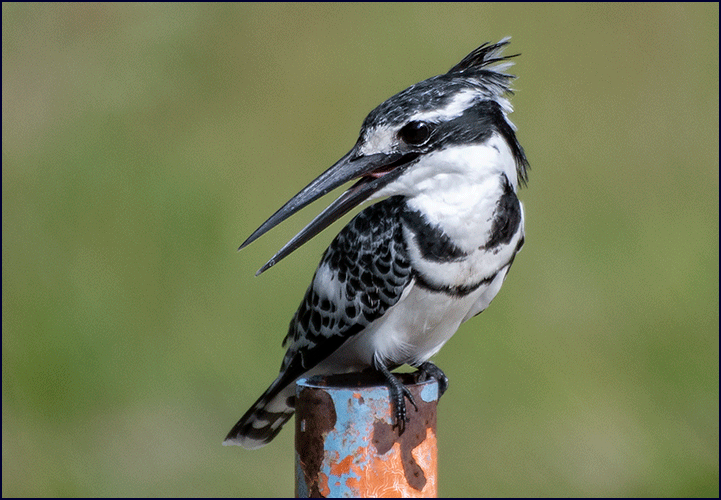
Pied kingfisher
|
The sides of the bridge and the concrete retaining wall
were painted white, and trimmed with light blue and black along
the edges. Gee pointed out a delightful thing: on the retaining
wall at the end of the bridge the expanse of white was liberally
covered with blue and black handprints, randomly placed and
somewhat smeared, with drips of paint running down. Gee asked us
who we thought had made these markings - was it children’s hand
prints, perhaps for some school art project? No, he told us, the
park service had painted the bridge to celebrate the anniversary
of freedom, and then the baboons had come and run through the wet
paint and then put their hand and foot prints all over the wall. I
loved this story. I could just picture those baboons creating
their graffiti bridge art.
We followed a track along the river. A monitor lizard moved
through the tall grass and then slipped into the water. These huge
lizards have a somewhat comical side-to-side waddling gait on
land, but are all grace and speed once they are in the water.
|
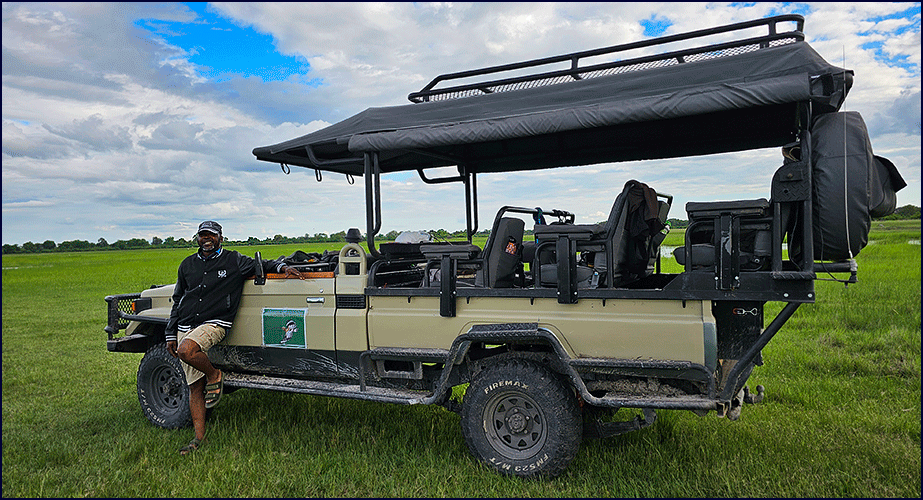
Gee at Lechwe Plain |
It was about five thirty when we came to Lechwe Plain,
where the Khwai River meandering through a wide open floodplain.
The sky seemed huge, with towering bands of grey and white clouds
accenting the deep blue. Herds of lechwes were grazing, and a few
round plump hippos could be seen grazing, out of the water.
Saddle-billed storks and egrets complemented the peaceful scene.
We got out of the land cruiser to enjoy the beautiful evening. We
were in the middle of the wide expanse, with a spectacular view
all the way around us. We took a few group photos and some
panorama shots. Natalie climbed up on the roof of the vehicle to
get an unimpeded 360 degrees pano photo.
Presently we continued on around to the other side of
Lechwe Plain. As the sun moved lower, the sky took on subtle
shades of pink near the horizon. A herd of lechwes ran across in
front of us, leaping through the shallow water. They were backlit
by the golden light of the setting sun, and the water droplets
flying up glittered silver. It was magical.
At six thirty Gee took us back to the hyena den - this time
the hyenas were out! There were three adult females and six
babies. Two of the mothers had two very young cubs each, and the
third had just one which was a little older. There was another
little cub whose mother was not there. The younger cubs were very
dark in color, almost black, and very small – they were probably
not more than three weeks of age. The older one, quite a bit
bigger, had gotten his spotted coat.
We were over the moon to be so close to these youngsters.
Hyenas are not the most beautiful of animals, but the babies are
amazingly cute.
The mother hyenas did not seem to mind our being there
watching them. The youngsters would play, then nurse a little,
then sleep a while before waking up to play some more. As the
evening went on the babies became more active; they romped and
wrestled, climbing on each other and over all three mothers. The
moms were very patient and loving with the babies; hyenas make
great mothers. The light had been a little dim for photos, but
suddenly the lowering sun broke through the clouds and rays of
late sunshine bathed the hyenas in golden light.
The young cub whose mother was absent had a white spot on
the top of his neck, so of course we named him Spot. He went from
one of the moms to another trying to suckle, and though they were
kind to him they would not let him nurse. We felt sorry for Spot
because he seemed hungry; we kept hoping his own mother would
come. Eventually one of the other moms seemed to take pity on him
and let him latch on to a nipple and suckle for a few moments,
which made us feel better. Also, we did note that Spot was plump
enough and appeared well fed; perhaps his mother had been there
earlier and already fed him.
As it got darker the adult hyenas started to move around.
Two of them stood nose to tail and examined each other’s private
parts. Gee told us that female hyenas have false male genitals
that look like a penis, so it is next to impossible to tell their
sex just by looking at them. Hyenas have a matriarchal society,
and the larger females dominate the males.
The cubs were still romping and cavorting, playing tag, but
you could tell they were getting tired. As it became fully dark
the mothers started to encourage the cubs to go into the den for
the night. This was not easy; the babies were still running to and
fro, with the older spotted cub going further afield.
Apparently hyenas are not any easier to herd than cats. Gee
said the cubs would sleep in the den for the night, and the adults
would go off to hunt and scavenge. In the morning the mothers
would probably come back to feed the babies again, and then go off
and sleep for the day. The cubs are alone most of the time, except
for twice a day visits from mom for meals.
Another adult hyena arrived; Gee said it was a male. He had
a half grown youngster with him that would probably stay in the
den for the night as well. All the hyenas started whooping and
calling softly to each other. Before long all the babies were in
the den, and the adults loped away for their night’s business of
finding food. OMGMF, what a fantastic sighting.
We made our way back to camp in the pitch dark. We paused
for a buffalo in the road. At one point Gee stopped near the river
and turned off the engine and told us to just listen. The chorus
of singing frogs was amazing; Gee said there were both reed frogs
and guttural frogs. I tried to record the sounds. One thing I
really liked about Khwai is that we were allowed to do night
drives, which are not permitted in most of the parks.
Back at camp, we sat around the fire. When Mosa came to
announce dinner we were surprised to hear that we were having
fish! It seemed a very long time since we had seen those fishermen
in the morning. Maybe our dinner was not tilapia fresh caught out
of the Khwai River, but it was delicious nonetheless.
It
was pretty much unanimous that the hyena den was the highlight of
the day, but the lechwes running through the water was a close
second for me. And oh, don’t forget that magnificent pair of
honeymooning lions in the morning! We realized that we had not
seen a single elephant that day.
We could hear hyenas in the night as usual. After the frog
chorus quieted down, I listened to the low calls of lions well
into the morning.
~
Continued
on next page ~
Africa
2024 Pages:
1
2
3
4
5
6
7
8
9
10
11
12
Back
to the AFRICA 2024 INDEX Page
|